Related Research Articles

Squid are cephalopods in the superorder Decapodiformes with elongated bodies, large eyes, eight arms and two tentacles. Like all other cephalopods, squid have a distinct head, bilateral symmetry, and a mantle. They are mainly soft-bodied, like octopuses, but have a small internal skeleton in the form of a rod-like gladius or pen, made of chitin.
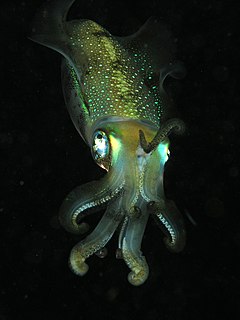
A cephalopod is any member of the molluscan class Cephalopoda such as a squid, octopus, cuttlefish, or nautilus. These exclusively marine animals are characterized by bilateral body symmetry, a prominent head, and a set of arms or tentacles modified from the primitive molluscan foot. Fishermen sometimes call cephalopods "inkfish," referring to their common ability to squirt ink. The study of cephalopods is a branch of malacology known as teuthology.

Subclass Coleoidea, or Dibranchiata, is the grouping of cephalopods containing all the various taxa popularly thought of as "soft-bodied" or "shell-less," i.e., octopus, squid and cuttlefish. Unlike its extant sister group Nautiloidea, whose members have a rigid outer shell for protection, the coleoids have at most an internal cuttlebone, gladius, or shell that is used for buoyancy or support. Some species have lost their cuttlebone altogether, while in some it has been replaced by a chitinous support structure.

Bigfin squids are a group of rarely seen cephalopods with a distinctive morphology. They are placed in the genus Magnapinna and family Magnapinnidae. Although the family is known only from larval, paralarval, and juvenile specimens, some authorities believe adult specimens have also been seen. Several videos have been taken of animals nicknamed the "long-arm squid", which appear to have a similar morphology. Since none of the seemingly adult specimens has ever been captured or sampled, it remains uncertain if they are of the same genus or only distant relatives.

Taningia danae, the Dana octopus squid, is a species of squid in the family Octopoteuthidae. It is one of the largest known squid species, reaching a mantle length of 1.7 m (5.6 ft) and total length of 2.3 m (7.5 ft). The largest known specimen, a mature female, weighed 161.4 kg (356 lb).

Promachoteuthis sloani is a species of squid from the northern Atlantic Ocean. It is known from only three specimens and very little is understood of its biology. P. sloani is characterised by several morphological features: nuchal fusion is absent between the head and mantle, the arms generally bear 3–4 series of suckers, and papillae are present on the tentacles.
Moroteuthopsis longimana, also known as the giant warty squid or longarm octopus squid, is a large species of hooked squid. It attains a mantle length of at least 85 cm and probably over 1.15 m. The largest complete specimen of this species, measuring 2.3 m in total length, was found in Antarctica in 2000.
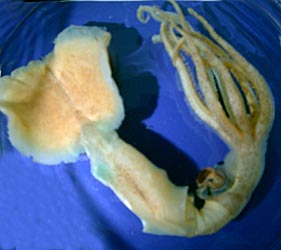
Asperoteuthis mangoldae, previously known as Asperoteuthis sp. A, is a chiroteuthid squid known only from the waters off the Hawaiian Islands. It differs from the closely related Asperoteuthis acanthoderma in lacking integumental tubercles and elongate fins. This species also possesses a characteristic curved groove in its funnel locking apparatus.

Asperoteuthis is a genus of chiroteuthid squid comprising four species:

Histioteuthis bonnellii, the umbrella squid, is a species of cock-eyed squid belonging to the family Histioteuthidae.

Sepiolina nipponensis, also known as the Japanese bobtail squid, is a bobtail squid and the only species in the genus Sepiolina. It is found in the Western Pacific in apparently widely separated populations, the most southerly of which is in the Great Australian Bight in South Australia and West Australia and then there are populations from the Philippines northwards to Taiwan, Fujian and southern Honshū.
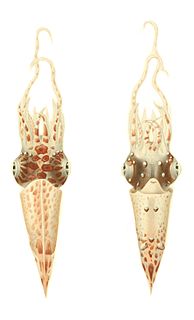
Pterygioteuthis giardi is a species of squid in the family Pyroteuthidae. It is known as the roundear enope squid. The specific name honors the French zoologist and marine biologist Alfred Mathieu Giard (1846-1908).

Muusoctopus levis is a species of octopus in the family Enteroctopodidae. It was first described by William Evans Hoyle in 1885 in an article in the Annals and Magazine of Natural History detailing the new species of octopus found on HMS Challenger as part of the Challenger expedition; the type specimen was retrieved from the Southern Ocean. The species is found in subantarctic waters in the Southern Ocean, particularly surrounding Heard Island and Kerguelen Island, but specimens comparable to M. levis have also been found at the Antarctic Peninsula.
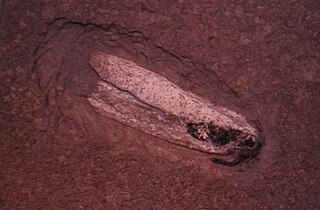
The gladius, or pen, is a hard internal bodypart found in many cephalopods of the superorder Decapodiformes and in a single extant member of the Octopodiformes, the vampire squid. It is so named for its superficial resemblance to the Roman short sword of the same name, and is a vestige of the ancestral mollusc shell, which was external. The gladius is located dorsally within the mantle and usually extends for its entire length. Composed primarily of chitin, it lies within the shell sac, which is responsible for its secretion.
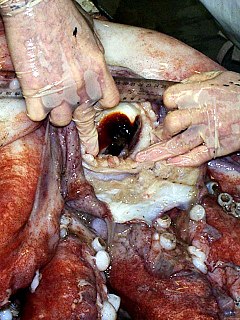
All extant cephalopods have a two-part beak, or rostrum, situated in the buccal mass and surrounded by the muscular head appendages. The dorsal (upper) mandible fits into the ventral (lower) mandible and together they function in a scissor-like fashion. The beak may also be referred to as the mandibles or jaws.

Teuthowenia megalops, sometimes known as the Atlantic cranch squid, is a species of glass squid from the subarctic and temperate waters of the northern Atlantic Ocean. They are moderately sized squid with a maximum mantle length of 40 cm (16 in). Their very large eyes are the source for the specific name megalops. Like other members of the genus Teuthowenia, they are easily recognizable by the presence of three bioluminescent organs (photophores) on their eyeballs.
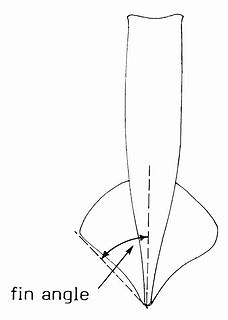
Cephalopod fins, sometimes known as wings, are paired flap-like locomotory appendages. They are found in ten-limbed cephalopods as well as in the eight-limbed cirrate octopuses and vampire squid. Many extinct cephalopod groups also possessed fins. Nautiluses and the more familiar incirrate octopuses lack swimming fins. An extreme development of the cephalopod fin is seen in the bigfin squid of the family Magnapinnidae.

Cephalopods exhibit various dermal structures on their mantles and other parts. These may take the form of conspicuous warts, cushions, papillae or scales, though in many species they are microscopic tubercles. The most elaborate forms are found among the oceanic squid of the order Teuthida.

Uroteuthis is a genus of 14 species of common inshore squids of the Indo-West Pacific and is further subdivided into 3 subgenera. The members of the genus Uroteuthis are the only squids of the family Loliginidae that possess photophores and all species in the genus have a pair of photophore organs on the ventral surface of their ink sac either side of their intestine.

Neorossia caroli, the Carol bobtail squid, is a species of bobtail squid belonging to the family Sepiolidae.
References
- 1 2 3 4 "Richard E. Young Emeritus Professor of Oceanography". School of Ocean and Earth Science and Technology, University of Hawaii. Retrieved 2 March 2018.
- 1 2 "Dr. Richard E. Young". Gulfbase. Harte Research Institute for Gulf of Mexico Studies. 2017. Retrieved 2 March 2018.
- ↑ Richard E. Young; Michael Vecchione; Katharina M. Mangold (1922-2003) (2018). "Cephalopoda Cuvier 1797. Octopods, squids, nautiluses, etc". Tree of Life Web Project. Retrieved 2 March 2018.
- 1 2 Julian Finn (2016). "Discoteuthis laciniosa Young & Roper, 1969". World Register of Marine Species. Flanders Marine Institute.